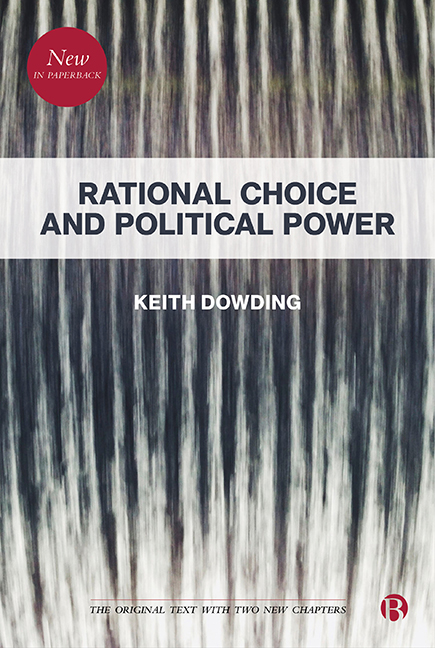2 - Rational Choice and a Theory of Action
Published online by Cambridge University Press: 30 April 2022
Summary
Rational choice
In this chapter I will explain the rational choice method and demonstrate that it is individualistic and yet explains by describing the structures which condition choice. The rational choice or economic approach to the study of politics is now well known in political science. Its proponents proclaim many advantages over ‘sociological approaches’ (Barry, 1978) though it is not without its difficulties and critics (for example, Hollis and Nell, 1975; Hindess, 1988, 1989). In my view the main difficulty with rational choice is that too many claims are made in its name – usually by its critics. It cannot and is not supposed to provide the final or definitive explanation of political behaviour and political outcomes that is sometimes presumed to be its objective. Rather, rational choice is a way of generating questions about society by modelling social situations. A model of a social situation is just a description of it. A rational choice description of a social situation picks out certain features of that situation and is a good model – and a good description – when those features are the important ones. The important features of a good rational choice model are not the basic assumptions of the rational choice method – which are contained in all rational choice models – but the specified relations between the actors. The model describes the relationships (and hence the individual properties) of all of the actors. A good model should replicate the structure of the situation it describes and tries to explain. The structure of the model together with the rational choice assumptions determine the outcome. How good rational choice is as a method is determined by how good its general assumptions are. How good each model is as an explanation of a particular situation is determined by the structural fit. The assumptions which make the models rational choice ones govern the ways in which individuals make their decisions about how they are going to act. However it is the structure of the individual choice situations that does most of the explanatory work. It is the set of incentives facing individuals which structurally suggest behaviour to them; by studying those incentives together with assumptions about the way actors make decisions we come to understand why people act as they do.
- Type
- Chapter
- Information
- Rational Choice and Political Power , pp. 19 - 30Publisher: Bristol University PressPrint publication year: 2019

